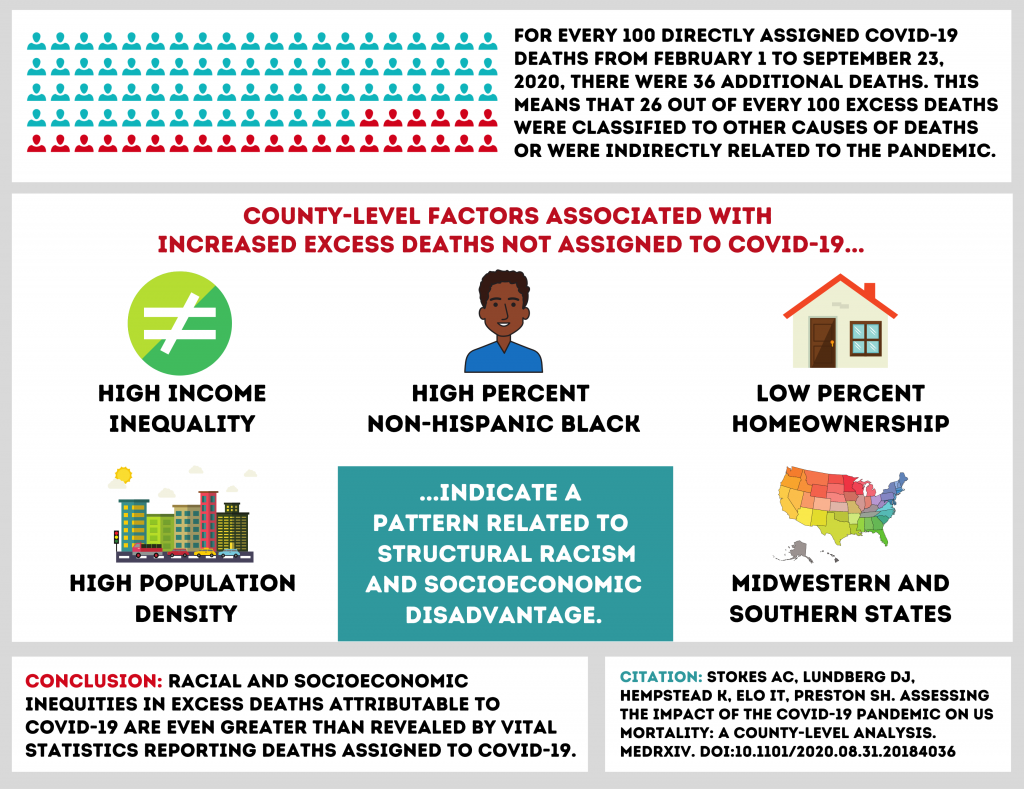US COVID Deaths May Be Undercounted by 36 Percent.

Over 200,000 people in the United States have now died from COVID-19, according to the Centers for Disease Control and Prevention (CDC). But the death toll of the US epidemic is likely much higher, according to a new, first-of-its-kind School of Public Health study.
Available as a pre-print on medRxiv ahead of peer-reviewed publication, the study estimates the number of deaths from February through September 2020 above what would be expected in a normal year, or “excess deaths.” For every 100 excess deaths directly attributed to COVID-19, there were another 36 excess deaths. This means 26 percent of all excess deaths were not directly attributed to COVID.
The researchers from SPH, the University of Pennsylvania, and the Robert Wood Johnson Foundation found more of these additional deaths in counties with greater income inequality, more non-Hispanic Black residents, less homeownership, and high population density, indicating a pattern related to socioeconomic disadvantage and structural racism.
“Excess deaths can provide a more robust measure of the total mortality effects of the pandemic compared to direct tallies of COVID deaths,” says study lead author Andrew Stokes, assistant professor of global health at SPH. “Excess deaths include COVID deaths that were ascribed to other causes as well as the indirect consequences of the pandemic on society.”
These indirect consequences could include fear of going to the hospital for another condition, or any number of issues caused or exacerbated by COVID’s economic and mental health impacts.

Stokes and colleagues analyzed county-level mortality data from the National Center for Health Statistics (NCHS) for 1,021 counties with 10 or more COVID deaths from February 1 to September 23. Previous studies have estimated excess deaths at the national and state levels, but this is the first study to examine the question at the county level, allowing the researchers to examine how patterns of excess deaths vary by demographic and structural factors.
The researchers used CDC data from 2013 to 2018 to estimate how many deaths each county would have been expected to have during this period if not for the COVID pandemic (as death rates are not constant from year to year).
They found that, for the 249,167 total excess deaths in these 1,021 counties, there were 183,686 deaths directly assigned to COVID on death certificates, and another 65,481 excess deaths not officially assigned to COVID. This means 26 percent of all excess deaths were not directly attributed to COVID—or, in other words, that excess deaths were 36 percent higher than the number directly attributed to COVID.
“Counties with high levels of COVID-19 mortality also had exceptionally high levels of mortality in 2020 from other causes of death,” says study senior author Samuel H. Preston, professor of sociology at the University of Pennsylvania. “This result suggests that the epidemic is responsible for many more deaths than are attributed to COVID-19 alone.”
While most counties saw more deaths than would have been expected in a normal year, some saw fewer deaths. The researchers analyzed the relationship between these excess deaths and differences in demographics and structural factors using US Census data, finding that communities already known to have been most harmed by COVID-19 have lost even more lives to the pandemic than official numbers show.
“Our results focus important attention on the disparate impact of the COVID-19 pandemic on low-income and minority communities which have historically experienced high death rates and that are now further exacerbated by the current pandemic,” says study co-author Irma T. Elo, professor and chair of sociology at the University of Pennsylvania.
“Racial and socioeconomic inequities in US mortality have widened significantly as a result of the COVID pandemic, especially when considering total excess deaths,” says study co-author Dielle Lundberg (SPH’19), a research fellow in the Department of Global Health. “To protect public health, policymakers must act decisively to address structural racism and reduce income inequality.”
The study was also co-authored byKatherine Hempstead of the Robert Wood Johnson Foundation, and was funded by the Robert Wood Johnson Foundation.